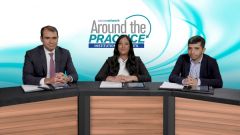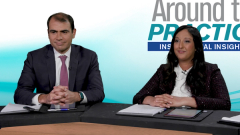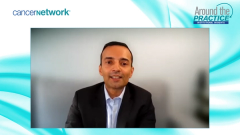
BCMA-Targeting Bispecific Antibodies in RRMM: Optimal Management of CRS
Focused discussion from a panel of key opinion leaders on the presence and management of cytokine release syndrome alongside BCMA-targeted therapy in relapsed/refractory MM.
Episodes in this series

Transcript:
Ajai Chari, MD, PhD:We spent the first chunk of the time talking about the efficacy of this amazing target and construct teclistamab but now let's switch gears to the safety profile of bispecifics targeting BCMA. Maybe, Al, we could start with you. You talked to us a little bit about the teclistamab approval study. One of the things that might be the most unique for those centers because we have to acknowledge that bispecific clinical trials are often also being done at centers like ours with CAR-T experience. One of the newest challenges for community folks that may not have experienced with either one is cytokine release syndrome. If you could tell us a little bit about that and the frequency manifestations from teclistamab study.
Alfred L. Garfall, MD, MS: Just like with CAR T-cell, bispecific T-cell engagers activate T-cells in a similar fashion. You do get this cytokine release syndrome, inflammatory syndrome that seems to go along often with response. Its low-grade form. It manifests as just fevers or perhaps occasional low blood pressure or mild hypoxia but it has the potential to be more severe with requirements for ICU care to manage hypotension or respiratory distress and even the potential to be fatal due to refractory hemodynamic collapse. With teclistamab, almost all the cytokine release syndrome was low grade. Almost all patients had cytokine release syndrome. Roughly in line with the response rate. About 70% of patients had cytokine release syndrome. About half of those patients required some anti-inflammatory therapy, namely tocilizumab. The anti-IL6 receptor antibody had very reliably calmed CRS down. That allowed the CRS to stay low grade but that still highlights the need that those patients who received tocilizumab were developing some real concerning signs that perhaps without that agent available might have headed down the road towards higher grade CRS more complications. If you look across the bispecific antibody studies, again, with all the caveats about cross-trial comparisons, you see a little bit less high-grade refractory cytokine release syndrome than you might see with CAR T-cells. I think that speaks perhaps for the ability of it to be managed outside some of these specialized centers. I still think it will be a learning curve. You won't have to have the cellular therapy infrastructure that you do in a CAR T-cell program to give these therapies, but you will have to have some comfort level and systems in place to manage these toxicities. Places that will be able to prescribe and give teclistamab may not have had that prior experience with CAR T-cell. That's great. It'll be more accessible, but I think it will also require a bit of training and learning curve at these other centers.
Ajai Chari, MD, PhD:This summarizes the CRS across all the bispecifics as Al just mentioned. There again, across the board, we're not seeing a lot of high-grade toxicity with CRS which is reassuring and it speaks well. We'll talk a little bit more about that. Just wanted to also mention that there is a REMS program with teclistamab because of the novel construct and approach of treating myeloma. If we could go to the next few slides, which has the label. That's the approval. We should just emphasize that this approval is for patients who've had at least 4 lines of therapy, including a PI, an IMiD, and a CD38. This is the dosing and schedule, which I want to come back to Al for a little bit, but specifically to the CRS, the recommendation is that patients should be admitted for 48 hours after each dose. I'll start with Al, but just across the board going back to the previous slide, the dosing. The table is here. It's day 147. The step-up doses of 0.06, 0.31, 0.5. What have you done in practice on clinical trials and in guidelines about this dosing schedule?
Alfred L. Garfall, MD, MS: These step-up doses of kind of giving a small medium and then the full dose of the drug. It's thought maybe to reduce the risk of severe cytokine release syndrome and neurologic toxicity that you might get by activating everything all at once with a larger dose of the medication from the outset. The prescribing information, while it kind of lays out this stereotype schedule of day 1, 4, and 7, it does give flexibility to give the subsequent dose as soon as 2 days after the prior dose. That is in line with our experience in the clinical trial. What's interesting about these bispecifics, and I'm curious to hear what others say from experience with other agents. It is a little bit unpredictable when patients get cytokine release syndrome. Some patients get cytokine release syndrome and remarkable myeloma responses after that first very small dose. Other patients, not until they get to the full dose. You can imagine, the way we've seen it on the clinical trials is that some patients might come in first dose, nothing happens. Two days later, you're ready to give the second dose, and then after that dose, you have some real fevers that might drag on for a couple of days, require a little bit more observation, maybe require tocilizumab, and then once that resolves, you can go ahead and give the third dose. With that subsequent dose, after having an initial cytokine release syndrome, it's unlikely that you have a recurrence. It is possible to have a recurrence. It tends not to be maybe as substantial as the prior, especially if tocilizumab was given. That seems to protect you from recurrent CRS with the subsequent dose. There is some unpredictability there and it's nice that there's the flexibility if things are going smoothly to give the subsequent dose as soon as 2 days after the prior dose. I think you must set patients up with the expectation that this process of giving these sequential doses stepping up could play out over the course of 1 to 2 weeks perhaps. Our approach initially will be to give these doses in the hospital and in the simplest scenario, a patient gets a dose one day, another dose 2 days later, another dose 2 days later, remains for 48 hours for observation, and is able to go home but with potential though that that hospitalization could be prolonged if any type of complicated or prolonged cytokine release syndrome develops.
Ajai Chari, MD, PhD:The footnote of the label actually alludes to what you just said. Even though we have day 1, 4, 7, there's a leeway to do it as close as 48 hours. You I think set this up nicely. Sham, maybe you could tell us a little bit about maybe the differences with the CRS management with CAR-T and bispecific and how you approach CRS in bispecifics.
Sham Mailankody, MD: Both products have a high proportion of patients having CRS. I think Al alluded to one of the differences is we see very few, if any, grade 3/4 events with bispecifics which is good. Most of the CRS is grade 1 and 2. That's true in the trials. It's true based on our experience as well. Over the years, both with CAR T-cell and with bispecifics, I think we have a much higher degree of comfort and knowledge that early treatment does not impede efficacy of these drugs or in the case of CAR T-cell, these cells. We'll probably mitigate and shorten the duration of this toxicity. At our center, we've largely moved to kind of certainly considering TOCI with the first fever and if patients are very stable, maybe watch for a few hours, but early on we use tocilizumab for CRS with the bispecifics. Again, these are anecdotes and what the trial showed as well is most patients require maybe 1 or 2 doses of TOCI and they do well. Again, Al alluded to this. If you have CRS with 1 or 2 doses, it's less common to have recurrent CRS with subsequent doses. Not impossible, but less common. Early initiation, mostly low-grade grade 1 and 2, early initiation of tocilizumab, consideration of steroids for patients who have more severe symptoms like hypoxia or hypotension, other issues, which again, is probably less than 3% to 5% of patients on these bispecific antibodies.
Ajai Chari, MD, PhD:Just to clarify for the listeners that the label also includes the recommendations for pre-medications which does include dexamethasone 16 milligrams, acetaminophen, and an antihistamine. In addition to that, as I think Sham nicely illustrated the importance of intervening early, particularly because we keep emphasizing it's low-grade toxicity. Sham, you kind of alluded to this, but could just for those who may not be as familiar, the difference between grade 1 and 2 CRS and how that might impact a patient.
Sham Mailankody, MD: Grade 1 CRS would be fever for the most part, which is the most common symptom these patients experience. Everybody who has CRS has fevers and that's a 100.5 or greater. Some patients could have 102, 103 degrees Fahrenheit as fevers. The standard approach would be to at least give them Tylenol® supportive medications, fluids if necessary for maintenance. Like I said, a strong consideration of probably intervening with tocilizumab at that point as well to prevent further escalation. Grade 2, now we're talking about some hypoxia, oxygen requirement, fluid-responsive, hypotension, et cetera. This is probably about 10%, 15% of patients who get CAR T-cell. This is where I would consider maybe a second dose of TOCI and potentially consider also doses of steroids to minimize the risk of going into grade 3. Grade 3 is what we don't want which would be patients with significant hypoxia needing more than 40% FIO2, let's say, or significant hypotension reading, vasopressor support. Many of these patients will be in the ICU at this point. In these trials and in our experience with bispecifics, that's less than 3% to 4% of patients who are getting these treatments. The sooner you intervene with grade one and two CRS, the less you will see of grade 3 and 4. We do probably see a slightly higher number of patients who get CAR T-cells who develop grade 3 and 4, but that's also changing with earlier interventions with CAR T-cell patients as well. The goal should be to have very few grade 2s and hopefully none or very, very few grade threes and fours when we start treating. The key part is early identification and intervention of these toxicities when they develop, which is the reason why I think we admit patients or certainly monitor patients very, very closely for that first one week. The one other thing that if listeners are not familiar is that all the CRS, almost all of it, 99% is seen with these step-up dosing and the first full dose. It's almost never seen with second dose and beyond. We're talking about the first 2 weeks of patients being on treatment in terms of the risk of CRS and neurologic toxicities.
Ajai Chari, MD, PhD:One of my favorite things I tell my patients is we don't give points for suffering so why let higher-grade CRS develop? The panel agrees we all intervene early. We don't wait for more severe CRS. Give that TOCI early. Just another reminder for those who may not be familiar with TOCI as with all monoclonal antibodies, has a long half-life. Particularly with bispecifics because you're giving multiple gradual step-ups. Sometimes you don't always need multiple doses like in CAR-T setting.
Transcript edited for clarity.
Newsletter
Stay up to date on recent advances in the multidisciplinary approach to cancer.






















































































